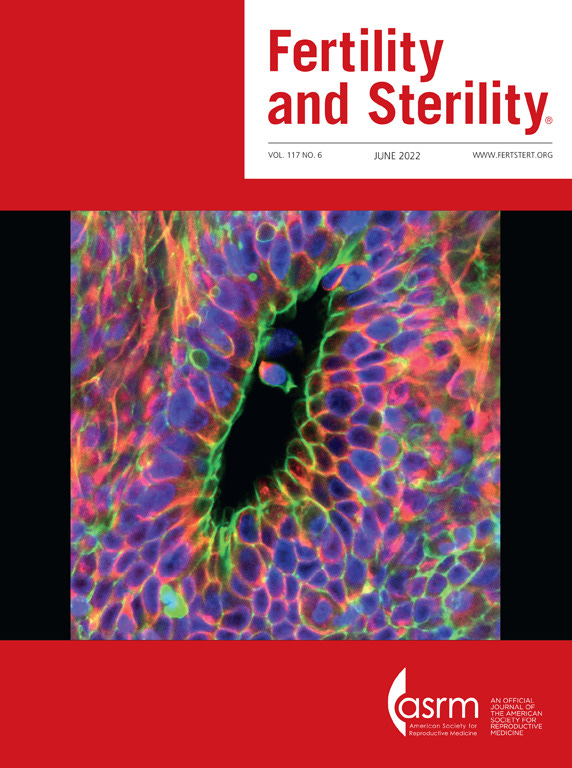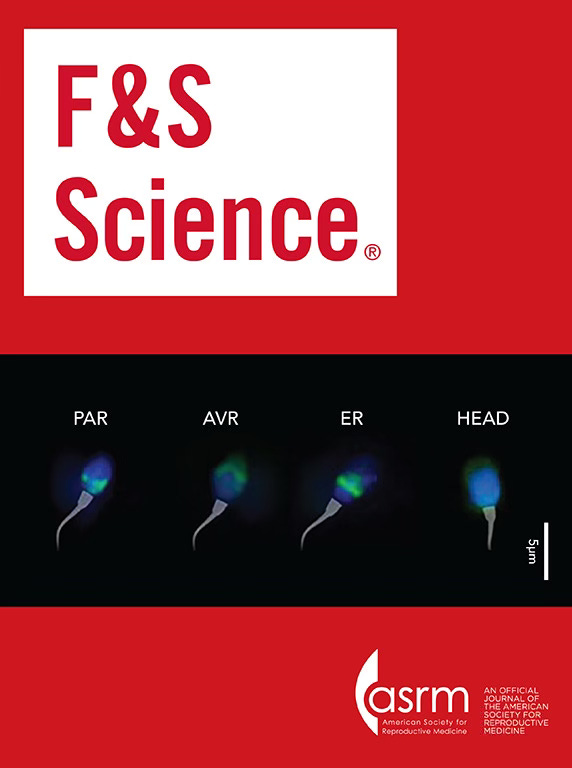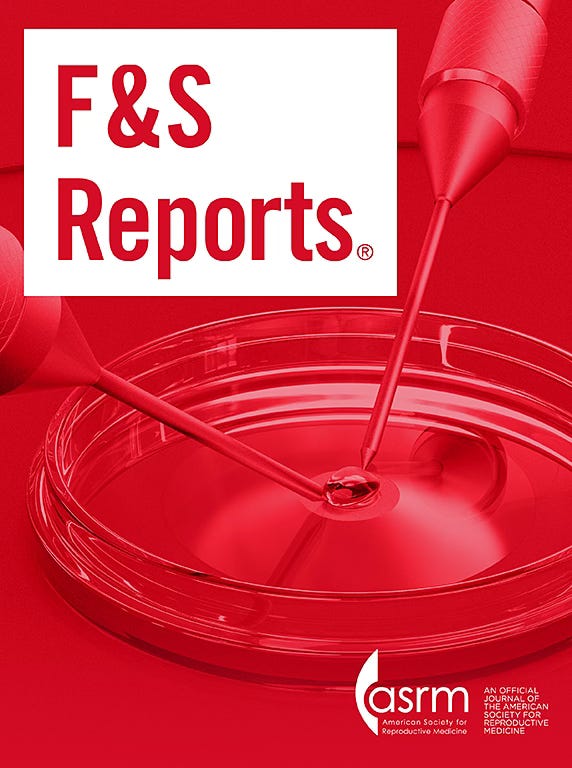What has been happening to our medical journals? Fertility and Sterility as an example
An Editorial of the shortcomings of the medical publication industry.
Shortcomings in the medical and general scientific publication enterprise are becoming increasingly more obvious, with voices suggesting a need for radical reorganization increasing in numbers as well as volume. The same sense also permeates medical publishing in the infertility field. By being the mother journal among F&S Journals, owned by the ASRM, Fertility and Sterility (F&S) is the leading U.S. medical journal in Reproductive Endocrinology and Infertility (REI) and reflects U.S. REI. The journal, therefore, presented itself for several reasons as a powerful example for changes that have taken hold in medical publishing, which deserve not only criticism but also mandate change. Here presented article, therefore, clearly centers on F&S, though it does so not in a personal way, but as an example for all of medical publishing. We hope that this Editorial will be understood as such.
So let us be clear, what is happening to journals in reproductive medicine is not unique. What we will be describing here, with reference to mostly infertility, applies not only to fertility-related medical journals. All the points we will be making, very likely also apply to many—if not most—medical journals in other medical specialties. But since REI is our specialty area, we—of course—feel a special obligation to REI journals and other medical journals with relevance to our specialty.
So, let’s get going: (i) Our journals have forgotten what they are here for. Their principal purpose was from the beginning – and in our opinion still is – to inform practice as objectively as possible in a timely fashion about new and important findings and developments in our specialty. What, at least in our opinion, they are not here for is to feed us with what selected “experts” believe are important new findings in our specialty, how they should be interpreted, and how they should be clinically applied.
In practical terms, this means that our journals should, of course, publish scientific papers—one after the other—after they, by careful peer review, were found worthy of publication. Every accepted (and well-edited) manuscript should, therefore, have an interesting story to tell that does not require further augmentation or explanation by a commentary, as has become fashion in Fertility and Sterility and its offspring F&S journals.
We already here—at the very beginning of this Editorial—want to apologize for the obviously disproportional attention given in this communication to F&S (for example, in comparison to Human Reproduction) and its offspring journals, but F&S is the most important journal in our field in this country. We find it especially painful when we see it deviating from what we consider to be its principal purpose.
(ii) The broken peer review process. At the end of this section of the CHRVOICE and following the earlier reports in this section, there, likely, is not much need to explain why we consider the peer review process broken, - but a few issues – once again best reflected in F&S, deserve further discussion: Let us start with what every publisher, editor, and author wants from a medical journal, a good and ever-improving citation index.
And it didn’t take a genius to discover that scientific papers are usually much more sparsely cited than opinion papers and review articles. So, what did many medical journals end up doing? They published ever increasing numbers of “expert” opinions in form of commentaries and, of course, review articles with attached meta-analyses (the latter—as noted above—not infrequently the product of commercial paper mills) and in our opinion—contrary to widely held believes—in a large majority of cases not even wort the paper they are written on because no other paper category in medical and scientific journals fits better the old IBM dictum, “garbage in, garbage out.”
So, what were then the consequences: less and less original science, and more and more “expert opinion,” the lowest evidence level on the evidence pyramid and further augmented by a steadily increasing flood of completely worthless, often AI-generated review articles with meta-analyses.
But even that is not the end of the story, and, once again, F&S is a good example. What we are talking about now is what we have come to call the self-perpetuating circular reinforcement of opinions, characterized by reviewers, based on their subjective judgments, having recommended to the editor acceptance of a paper and then having been given the opportunity to reemphasize their judgment by writing a commentary to the paper they recommended for acceptance.
We believe that this kind of policy is harmful because published papers already reflect the opinion of the reviewer and the Editorial board (otherwise the paper would not have been published). What is needed at this point is a commentary that is critical of the publication and not only a reinforcement of the paper’s message.
This circular reinforcement of opinions is further aggravated by how editors at practically all journals choose referees: Reviewers are usually chosen by editors based on their expertise in the subject the paper addresses, and that means that they usually have distinct opinions on the subject they are asked to review, a polite way of saying that they, by definition, must be biased.
To offer an example for the unpreventable consequences of this circular reinforcement of biased opinions in the peer review process, investigators at the CHR—literally for decades—have had difficulties getting papers that criticized PGT-A accepted because reviewers were usually strong proponents of PGT-A who opposed the publication of manuscripts that criticized the test/ procedure. As a consequence, it took over 20 years for ASRM/SART to reach the opinion that PGT-A was useless in producing IVF cycle outcome benefits, as aggressively advocated by its proponents without proper evidence for over 20 years.1 As we noted elsewhere in this issue of the CHRVOICE, this, for example, also has been going on for an even longer time period in obstetrical practice in regard to continuous fetal heart rate monitoring2 and, with absolute certainty, is also happening routinely in other medical specialty areas.
The psychological effect on the reader is, of course, also substantial if a prominent journal like F&S not only publishes a paper with a distinct opinion but then also offers an “expert” commentary—invited by the editor—that further augments this (often biased) opinion, rather than invites a critical opinion about the published article.
(iii) What Editorial offices can and must do. To continue with F&S as an example, current practice must end, and the responsibility for this change lies with publishers (including professional societies that own many leading journals) and editorial offices at those journals. How absurd current practice is was again perfectly demonstrated by F&S with the publication of its recent “special issue” on embryo testing.3
Fourteen months after publishing the previously noted policy statement of ASRM/SART that PGT-A in over 20 years of clinical utilization in IVF has failed to establish even one clinical outcome utility,1 the editors of the journal made the very unusual – and to a degree unprecedented – decision to publish a special issue of F&S outside of the usual monthly publication schedule, entitled “HUMAN EMBRYO TESTING—Phased Validation: from Innovation to Practice.”
Considering the rather staggering policy statement by ASRM/SART in September of 2024 that PGT-A in over 20 years was unable to proof any clinical benefits in IVF (which—apropos—was published in F&S), this would seem like a very logical, even courageous decision, considering how much damage the rapidly growing practice of PGT-A has caused over these more than 20 years for thousands, probably even hundreds-of-thousands of patients and couples. One would furthermore assume that this special issue of F&S would address the reasons why and how it was possible that such a highly consequential misdirection in clinical IVF practice could have occurred, and what changes should be implemented to prevent similar misdirections in practice in the future.
But that did not happen!
Indeed, the opposite happened, as well demonstrated by the first few sentences of the brief introductory article of the four editors of this special issue of F&S, and we quote:
“The field of embryo diagnostics has undergone a remarkable transformation over the past few decades, evolving from rudimentary assessments of morphology to sophisticated genomic, morphokinetic, and molecular analyses. Preimplantation testing of human embryos—once a specialized adjunct to in vitro fertilization—is now a rapidly expanding domain with profound implications for reproductive decision-making, clinical outcomes, and ethical discourse. Yet, with these advances comes a challenge: how do we ensure that innovation translates into meaningful evidence-based improvement in patient care?”
Not a word about the September 2024 ASRM/SART policy statement, yet—paradoxically—a loud and clear acknowledgment that this alleged “progress” has so far produced no meaningful evidence-based improvement in patient care. And, of course, also not a word about the damage this alleged “progress” has caused to patients and the IVF field overall in over 20 years of PGT-A utilization in more detail by the CHR’s Medical Director and Chief Scientist, Norbert Gleicher, MD, in the introductory article to this issue of the CHRVOICE.
In 104 pages and 15 articles, only one article alone by Sarah Lensen, PhD, Marcella I Cedars, MD, and Sebastian Mastenbroek, PhD (8 pages, 7.7% of page volume), concluded that, “the current evidence does not justify the widespread use of PGT-A.” This stands in contrast to the following comparatively completely unimportant statements in other articles (the text in bold letter represents verbatim key quotes in those articles) in the two BOXES below.
• … a test should be demonstrated to have good characteristics in each stage of development before moving to the next one…6 but not a word about the ASRM/SART document about PGT-A.
• Currently, no embryo diagnostic method has been proven to increase the cumulative live birth rate for a given cohort of embryos,7 but not a word about the ASRM/SART document about PGT-A, and why then use PGT-A?
• Standardized, transparent analytical validation grounded in precision, accuracy, and feasibility will strengthen the PGT-assay development and deliver more reliable, clinically meaningful results.8 Basically, an acknowledgment that current PGT-A does not deliver reliable, clinically meaningful results, without saying it.
• Prognostic and diagnostic studies should immediately follow analytical validation and before clinical application of a test.9 And how about PGT-A?
• Recommendations for randomized trials with no comments regarding current PGT-A practice.10
• According to the authors only briefly discuss the legal and ethical obligations of genetics testing protocols.11
• PGT-A does not appear to increase obstetric or neonatal risks, but study variability and confounding factors limit certainty.12
The following 11 pages presented 6 “Editorials,” with 2 written by authors of above above-listed articles.
• The clinical advantage of these tests (i.e., PGT-A) is attained by correctly identifying those embryos with little or no reproductive potential and ranking embryos accordingly.13 PGT-A, of course, has never demonstrated the ability to “correctly differentiate with certainty euploid vs. aneuploid embryos.
• It is imperative to recognize the moments when the need for precision outweighs the value of brevity.14 The substance of this statement is truly amazing!
• Only a commentary about “the future” of reproductive medicine, with no obvious connection to the subject of the supplement.15
• A commentary on the ethics of heritable human genome editing, also with no direct connection to here subject discussed here.16
So, what was then the purpose of this special issue of F&S?
We wish we knew, but we can say with certainty that this special issue of F&S did not benefit U.S. and worldwide IVF practice. We can also say with certainty that avoiding a fair and open discussion of PGT-A was at least 10—and likely 15—years overdue when ASRM/SART finally published their joint committee document. Nobody is served well if patients continue to be misled, and their pregnancy and live birth chances continue to be adversely affected.
By practically completely avoiding this “never too late” document in their special issue of F&S, its four editors, in themselves an interesting combination of “experts,” however, ended up drawing attention to themselves: Probably most surprising and to a degree reflective of how F&S has been handling the PGT-A controversy since his ascension to the position, the editor-in-chief of F&S, himself, apparently took the lead in producing the special supplement (also being an author on 3/15 articles, 20%). Some editorial offices maintain a policy of no original articles from editors or their departmental colleagues except for clearly marked editorials.
The number two on the team of editors for the special issue was one of the most prominent and long-term proponents of PGT-A, with considerable responsibility for the misdirection of the field when it came to PGT-A. There, of course, was no balancing opponent of PGT-A among the editors because—somewhat paradoxically—the two other editors of the supplement issue are not known for any association or special expertise with the subject of PGT-A. One, of course, does not have to be a hands-on “expert” to develop valid judgment, but both of these editors are from France, where PGT-A is forbidden because it is not considered a medical necessity.
(iv) Ethical and professional responsibilities. We, that is, we physicians, we scientists, we reviewers, we editors, and, yes, we members of medical societies like the ASRM and SART, have professional responsibilities, and our first and foremost responsibility is “primum non nocere:” do no harm! And nobody can any longer claim that the utilization of PGT-A does not do harm every single day large numbers of women and couples undergoing fertility treatments.
In other words, it is no longer good enough—as ASRM has finally done—to agree that PGT-A does not improve IVF outcomes, but it is essential to point out the damage that PGT-A has done to so many patients over so many years by reducing their pregnancy and live birth chances because of misdiagnoses of embryos with pregnancy potential that were not transferred or were even discarded. And, indeed, thousands of such embryos are still cryopreserved, with most colleagues refusing their transfers. But that is not all: How about all of the women who were prematurely driven into third-party egg donation because PGT-A didn’t give them “transferable” embryos, and how about all of the women and couples who, simply, abandoned parenthood for the same reasons.
We can no longer simply accept that PGT-A does not improve IVF outcomes and have to, finally, face the truth that for many patients, PGT-A, indeed, harms pregnancy chances in IVF.
Why is this of importance?
Because “primum non nocere,” therefore, ethically no longer allows us to simply do nothing and continue in our ways with PGT-A practice as usual. And this is why the CHR perceives the recent special issue of F&S3 as so offensive. Reading this supplement, one gets the overall impression that “everything is fine as is.” There, indeed, is no reason why we should not just continue in our PGT-A utilization as usual. There is nothing to worry; sometimes in the future we will figure out how to do everything right, and, then and only then, will a beneficial utility for PGT-A become obvious.
This is, however, not how medicine is ethically practiced. Time for our medical journals and medical societies to speak up!
And a final positive word about F&S
That medical journals including F&S, can do better was recently demonstrated in a Reflections article in F&S (i.e., a commentary) by two scientists from Ireland and the U.K, respectively,17 who commented on an article in the same issue which attempted to present recommendations to improve the quality of nonrandomized studies of interventions (NRSIs) in fertility treatment research, addressing their roles as complements to randomized controlled trials (RCTs) in evaluating treatment outcomes, with the subject being patients undergoing IVF treatments.18 In doing so, the authors reported what they called a “multidisciplinary expert consensus,” by worldwide consensus the lowest level of medical evidence.
We are pointing these two articles out because they demonstrate exactly the point we earlier in this commentary attempted to make: Recognizing that even the best team of journal editors cannot and will not be perfect in deciding which manuscript to accept for publications and will overlook major errors in published papers, it behooves the journal – if a commentary is published – to choose “experts” as authors who are respectfully critical of the published manuscript. These two manuscripts demonstrate this point perfectly, as the following closing paragraph of the Reflections article demonstrates.
The recommendations of Schwarze et al. (name misspelled in article) help draw our attention to the importance of rigorous methods in assisted reproductive technologies (ART), where critical errors in the design and analysis of NRSIs are common. In an evaluation of PGT-A, investigators may include any participant with no embryos in a control group, on the grounds that they did not undergo PGT-A, introducing a form of immortal time bias. In an evaluation of an embryo culture medium, investigators might adjust for the number of embryos transferred, introducing bias because of overadjustment. The recommendations, if followed, will prevent instances such as these. Nonetheless, we believe it is important to hold the line. The NRSIs should be used when necessary, but the impracticalities and apparent ethical limitations of conducting RCTs should not be overstated.
Cudos to F&S in this case; we only wish this would happen more often!
References
Practice Committees of ASRM & SART. Fertil Steril. 2024;122(3):421-434
Kliff A. The New York Times. November 7, 2025.p1.
Fertil Steril 2025;124:5P1
Barnhart et al. Idem: 801
Lensen et al., Idem: 870-877
Barnhart et al., Idem: 802-811
De Ziegler et al., Idem: 812-821
Popovic et al., Idem: 822-838
Pirtea et al., Idem: 839-848
Wilkinson et al., Idem: 849-859
Capalbo et al., Idem: 860-869
Wang et al., Idem: 878-892
Franasiak J, Pirtea P. Idem: 893-894
Lee et al., Idem: 896-897
Penzias AS, Adashi EY. Idem: 898-899
Joffe S. Idem: 900-901
Dahly DL, Wilkinson J. Fertil Steril 2025;124(4):657-658
Schwarze et al., Fertil Steril 2025; 124(4):749-758





